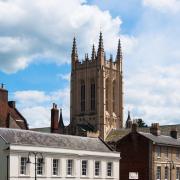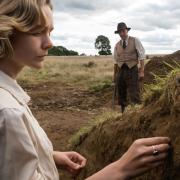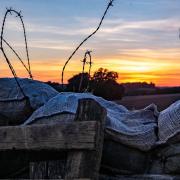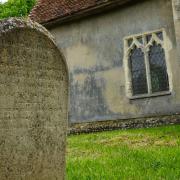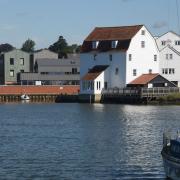Paul Botterill discovers the stories behind the names on the town’s memorial

There is no official record of the number of war memorials in the country but a joint Channel Four/Imperial War Museum project marking the centenary of the First World War identified in excess of 60,000. Six million British men were mobilised for that conflict of which 700,000 soldiers and 44,000 sailors never came home.
All over the country there were empty seats around family tables and no grave where the bereaved could easily mourn. Money was raised and monuments built, now part of our national landscape, frequently seen but not always noticed.
It was a sombre Sunday, 2 January 1921, the weather wretched for unveiling Aldeburgh’s memorial to the 83 men and one woman from the borough who never returned from the ‘war to end all wars’ that had ended just over two years before. The church clock had just struck 2pm and from every corner of the town, people headed towards Moot Green, pulled there as if by some magnet. Banks of lead grey clouds scudded low above the town driven by a strong southeasterly wind. Coal smoke blew from chimney pots in horizontal swirls and the crests of the waves whisked into spume as they crashed on the shingle. There was a smell of fish in the air with a salty tang. Gloved hands clutched collars and held hats in place, eyes streamed in the wind, or perhaps with emotion.

Read: what makes a Suffolk person?
More than 1,000 people gathered beside the Moot Hall, ancient epicenter of the borough, dating from the 16th century. Four hundred years later the burghers remained proud of their heritage. Not for them some outsider to unveil the tribute to their fallen, the mayor and corporation with the Lord of the Manor, Captain Vernon Wentworth, Royal Navy, would suffice.
A flag decked dais had been erected for the officials on the seafront, facing the memorial draped in a large union flag. On either side of the dais sat the parents and siblings, widows and orphaned children of the fallen. Those still serving the colour mingled with the discharged service men and women opposite the dais, completing the encirclement and behind them all, members of the public. Half way up the steps on each of the six sides of the monument stood three soldiers and three sailors, arms reversed, heads bowed, facing the crowd.
As the clock struck 2.30pm, the Leiston Works brass band under bandmaster Robert Peskett set off from the Moot Hall leading the civic procession around the square at a slow march, the mayor’s scarlet cloak, white ruff and gold chain the only colour in the parade of sober suits. The flags cracked like whips on top of the poles, their halyards humming a mournful note.
Everyone in place, the service of blessing started with the hymn For all the Saints followed by prayers led by the vicar, Canon Goldsmith, and a reading by the Union Chapel minister, the Reverend Culley. The mayor, Alderman Percy Clark, then pulled away the national flag to unveil the lofty cross of Portland stone set atop a hexagonal plinth where the 84 names are still inscribed – 84 out of the 270 inhabitants listed in the December 1915 parish magazine as serving in uniform.
ROLL OF HONOUR
The memorial unveiled, Mayor Clarke read the Roll of Honour in chronological order. Although a bachelor himself, his nephew, Alfred, had died on 7 January 1916 and later that year the Alderman funded a memorial in the High Street to the town’s fallen. Alfred had been the eldest of 10 children and a horseman on a local farm before becoming an ambulance driver in the Army. Alfred was taking wounded from the port of Salonika to the military hospital when Turkish and Austrian aircraft bombed the convoy. Alfred was injured, dying two days later from his wounds at the age of 21.
ARTHUR WINN
The first fatality of the conflict was thirty-year-old Captain Arthur Winn, a regular officer serving with the Second Battalion The Suffolk Regiment on 9 September 1914. The 2nd Suffolks had been in Ireland at the outbreak of war and arrived in Le Havre on 17 August before moving two hundred miles to Mons in Belgium in time to join the eponymous battle there on 23rd.
Routed by the advancing Germans, three days later they were in action again at the Battle of Le Cateau suffering heavy casualties before falling back to Favières on the river Marne, 130 miles to the southwest on 8 September. By now Arthur was the senior surviving officer and took command of the battalion which was reduced to two companies of two platoons each.
On the morning of 9 September the Suffolks counter-attacked across the Marne coming under heavy enemy fire from concealed positions. Arthur was killed in the exchange of fire. The tenacity of the 2nd Suffolk’s was legendary. They lost 724 men in three weeks after arriving in France but their sacrifice helped frustrate the Schlieffen plan and save Paris. Arthur’s parents lived at the Uplands opposite the church.
SIDNEY CABLE
Gunner Sidney Cable died from shrapnel wounds at the Battle of Loos twenty-five miles southwest of Lille in September 1915 at the age of twenty-three. Sid was one of four brothers serving in France. Older brother William, aged twenty-seven, was an ambulance driver having been a chauffeur before the war. He was in a vehicle accident at Calais six weeks after Sid died. His wounds turned gangrenous and fatal. He left a widow but no children. Almost two years later, in August 1917, 30-year-old Robert was killed serving with the Lincolnshire Regiment near Loos. The 4th Lincolnshires had been in the front line trenches for six days, working and fighting with water “up to their knees” and suffered heavy losses. Robert left a widow and four children. The oldest brother Edward survived. Their parents, Robert and Laura lived on the Town Steps by the water pump and their father was known as ‘Russian Bob’ because of time he spent in a Russian ship before becoming a fisherman and bowman of the lifeboat.
ALFRED LAWS
The oldest person on the memorial was Alfred Laws aged fifty-three. He was washed overboard from HM Drifter Golden News and drowned off the Antrim coast on 3 January 1916. Alfred had been the owner and skipper of the cod smack Victor and by all accounts a substantial man as well as a man of substance. The Victor was one of the last of the sailing smacks that ventured north to the Faroes and Iceland in search of cod. About fifty feet long they caught their quarry by long lining, baiting hundreds of hooks to catch the prized fish. The catch was kept alive in a seawater well until the smack returned to harbour when fish were lifted out and dealt a blow to the head; the fishermen and their vessels were known as “cod-bangers”. With the advent of war such fishing ceased and Captain Alfred joined the Naval Reserve as a deckhand in the Patrol Service, which operated a variety of converted fishing boats for minesweeping and anti-submarine warfare. The Golden News was protecting the Northern Channel between the Mull of Kintyre and the Giant’s Causeway, laying and lifting anti submarine nets to stop any U-boats getting into the Irish Sea to menace Liverpool. Handling warps under load as the ship pitched and rolled with waves washing over the deck was dangerous work. Alfred lived at 202 High Street, a house coloured Suffolk pink today sandwiched between the Fat Face and Joules shops. He left a widow and four children. There were more than fifty men from Aldeburgh serving in similar vessels.
PERCY PECK
The youngest Aldeburgh victim was Boy Seaman Percy Peck serving on HMS Russell. He turned 17 just seven weeks before she was sunk on 27 April 1916. Percy and his friend Bertie Knights volunteered at the outbreak of the war and even had sequential service numbers, J32333 and J32334. After initial training at HMS Ganges, Shotley, they were drafted together to HMS Russell, a pre-dreadnought battleship, sent to support the Dardanelle withdrawal in late 1915 and was the last Allied battleship to leave the Hellespont the following January.
After spending several weeks anchored off Cephalonia she arrived at Malta late in the evening on Wednesday 26 April. The King’s Harbour Master had closed the boom across Valetta Grand harbour because there were reports that a submarine had been sighted. Russell spent the night at sea steering anti-submarine zigzags while below the surface, Kapitänleutnant Gustav Siess in U-73 silently laid 22 mines in the approach channel. At 0530 as dawn was breaking Russell entered the channel planning to arrive as the harbour re-opened. Seven minutes later she came into contact with two mines. The after magazine exploded and the order given to abandon ship as Russell rolled onto her side before sinking slowly in 60 fathoms of water taking 27 officers and 98 ratings down with her. It was Easter week and the Dublin uprising dominated the front pages of the newspapers.
CHRISTINA JAY
The only woman on the memorial is Christina Jay a Sister in the Queen Alexandra’s Imperial Military Nursing Reserve who died on 12 August 1916 aged 37. Christina was one of 12,000 “QA’s” and was serving aboard HM Hospital Ship Takada, operating a shuttle taking the sick and wounded 1,500 nautical miles from Basra to Bombay. Following the defeat of General Townshend’s army by Halil Pasha at Kut-al-Amara, the two military hospitals in Basra were overwhelmed with casualties as well as patients suffering from cholera, yellow fever, spinal meningitis and bubonic plague.
The patients had to be loaded onboard mid stream in the Shatt al Arab because the quays were still under construction. With temperatures of about 50°C and 90 per cent humidity it was arduous work. Christina contracted yellow fever and died while Takada crossed the Indian Ocean on its way to Bombay. She was buried at sea. Her parents James and Sarah owned the Rowley Temperance Hotel on the Crag Path where they lived with Christina’s four sisters.
JACK READING
Jack Reading is the only member of the newly formed Royal Air Force on the memorial. He was the only child of Alderman Vernon and Alice Reading who were on the dais. Jack was flying the cumbersome RE-8 reconnaissance bomber, nicknamed the ‘Harry Tate’, with 15 Squadron Royal Flying Corps when the German Spring offensive started pushing the Allies back towards Paris in 1918.
At 4.40pm on 26 March Jack took off and twenty minutes later he was over the front line searching for German artillery positions. Further into the patrol Jack’s observer called through the voice pipe warning there were two bandits diving down on them. He fired the Lewis guns at the attackers one of which was the distinctive red tri-plane of Baron Manfred von Richthofen. Jack’s RE-8 spiraled earthward in flames and the Red Baron notched his second ‘kill’ for that day. Jack’s death was confirmed a month later on 26 April by which time the RFC had ceased to exist, becoming the RAF from 1 April although Jack never wore the new pale blue uniform. The Red Baron was killed five days before confirmation of Jack’s death. Jack’s parent lived at 50 High Street, a few doors away from the bookshop.
BOB KERSEY
Twenty-eight year old Able Seaman Bob Kersey was the final fatality of the war. Surrender discussions had been under way between the adversaries since late September and although hostilities continued, families were daring to hope their loved ones might make it home. It was not to be. Germany had ordered all U-boats to return to Kiel on 20 October but Oberleutnant zür See Hellmuth Von Doemming commanding U-67 seemed not to have received the signal.
At 20 minutes to midnight on 10 November, the day before the armistice, he sighted the paddle minesweeper HMS Ascot heading northwest towards the Firth of Forth at nine knots through his periscope. He fired a pattern of four torpedoes two of which found their target, breaking Ascot’s back in two places. The wintery North Sea rushed in, bulkheads collapsed inder the weight of the water and Ascot slid beneath the waves in three pieces all 53 of her company with her, the final naval casualty of the war. Bob’s widowed mother and two sisters lived at Bell Cottage in the High Street, built in 1805, the year of Nelson’s victory at Trafalgar.
There are 74 similar stories including seven fatalities at the Somme in July 1916, three aboard the torpedoed trawler Spotless Prince and the two Backhouse brothers who died within a fortnight of each other in the final weeks of the war. Each tale tragic, affecting the lives of mothers and fathers, brothers and sisters, widows and orphans. Simon Last’s and Michael Good’s book Aldeburgh War Memorial identifies 428 close relatives of the 84 when the population of Aldeburgh was less then 2,400.
The Roll of Honour completed, Canon Goldsmith recited Binyon’s immortal words, written following the retreat from Mons when the 2nd Suffolks suffered such losses;
They shall grow not old, as we that are left grow old;
Age shall not weary them, nor the years condemn.
At the going down of the sun and in the morning
We will remember them.
As a bugler sounded the Last Post and every man removed his hat and 1,000 people stood, heads bowed to say farewell to those they still loved but had lost forever. Twenty-five years later another 27 new names were added to this monument, as they were on most of the other 60,000 war memorials around the country.
PAUL BOTTERILL, author
Suffolk born, Paul Botterill served in the Royal Navy and is a Trustee of The Not Forgotten, a charity providing recreation and entertainment to the service and veteran community. His grandfather is one of the names on the Aldeburgh war memorial.
Find out more about Suffolk’s heritage. Join our Facebook group




